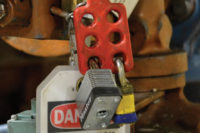An estimated 120 lives are saved and 50,000 injuries prevented each year by complying with OSHA lockout/tagout standards, according to the OSHA Fact Sheet on Lockout/Tagout, from the U.S. Department of Labor, Occupational Safety and Health Administration, 2002. Lockout/tagout, or LO/TO, is a procedure in which repairs are not made to machines until power sources are removed, locked out, tagged out and isolated. In response to this course of action, Graphic Products, Inc., has released the Safety Lockout/Tagout Best Practices Guide.
“A large percentage of workplace accidents, as well as OSHA citations, are related to not using LO/TO or not following LO/TO procedures. The Best Practices Guide was developed to help reduce accidents by providing foundational information about LO/TO. We've produced this free best practices guide for our customers and are happy to make copies available to anyone who needs to learn the basics of LO/TO,” said Steve Stephenson, Chief Marketing Officer, Graphic Products.
Included in this colorful guide are chapters about how accidental start-ups occur, a definition of stored energy, steps to install and remove lockout gear, a case study from an environmental health and safety professional plus an overview of commonly used LO/TO products and services. There’s also a section about reducing the number of potential injuries and fatalities possible from entrapment in confined spaces such as tanks and tunnels. LO/TO supplies include DuraLabel tag stock which includes holes to hang tags on piping systems and switches resists. Tag stock also resists moisture, UV rays and exposure to washdown chemicals.
OSHA’s standard for The Control of Hazardous Energy (Lockout/Tagout), Title 29, Code of Federal Regulations (CFR), Part 1910.147, addresses the practices and procedures necessary to disable machinery, thereby preventing the release of hazardous energy while employees perform servicing and maintenance activities. The standard outlines measures for controlling hazardous energies – electrical, mechanical, hydraulic, pneumatic, chemical, thermal, and other energy sources.
“LO/TO devices help reduce injury tremendously. Types of equipment impacted by LO/TO are light ballasts, switches, motors and pumps -- any equipment/circuit >50 volts to ground. Affected people are faculty, staff, and researchers,” said Jim Biddle, Manager, Industrial Hygiene & Environmental Programs, Northern Arizona State University.
OSHA suggests the following steps for workplace safety:
- Develop, implement and enforce an energy control program
- Ensure that lockout/tagout devices identify the individual users
- Provide effective training
With more than 50 unique labeling supplies, Graphic Products, Inc. is equipped to solve problems in the industrial safety arena -- providing the right label material for nearly every type of application including arc flash, pipe marking, facility safety, mining, food processing and construction.
Graphic Products carries a full family of thermal transfer printers for every application, and a five-year warranty on labels made with premium vinyl, free technical support. Satisfied customers throughout the world include P&G, Amazon.com, Georgia-Pacific, Boeing, John Deere, Conoco, Sara Lee, Toyota and General Electric. For more information, visit www.DuraLabel.com, email jarubinger@graphicproducts.com or call 800.788.5572, ext. 3024.

